In May 2019 I activated Mt Dandenong VK3/VC-025 with my latest homebrew rig. It was a CW only activation, five QSOs completed, but while I was handing out 599s, the reports coming back to me from the chasers were well down. Over the next few days on OZSOTA (the VK SOTA discussion group) several chasers made comments to the effect that they could hear other VK3s but nothing much from me. When regulars Tony VK3CAT, Ron VK3AFW and Gerard VK2IO reported the same thing, the evidence for a problem at my end mounted.
With the rig on the bench, the problem became clear — only 2.4v peak to peak into a dummy load. That’s 15mW. The IRF510 PA FET was blown. I’d managed five QSOs including VK2, VK3, VK5 and VK7 with nothing more up the stick than driver leakage. That seems incredible. But hams have been making contacts with tiny QRPp power levels for decades, and with good antennas and today’s receivers, huge miles per milliwat contacts are do-able.
VK QRP Challenge
My OZSOTA group confession sparked speculation about how effective QRPp could be on a summit, even during the sunspot low. Mention was made of the remarkable results from the UK/European PP3 Challenge, in which SOTA activators used 200mW rigs powered only by an alkaline PP3 9v transistor battery. Over 200 QSOs on the one battery were achieved by several PP3 activators. After more discussion Ron VK3AFW proposed a VK QRPp challenge, set for a weekend later in the year. Simple rules …
‘Score to be no of chasers worked divided by power in watts. Special mention for longest distance worked. Separate summits treated as separate and not cumulative.’
Half a dozen activators jumped in with promises to mod a RockMite, or a Pixie, or scratch build. Various kits, eBay options, circuits and URLs were posted. Compton VK2HRX considered modding his garage door opener. The game was on.
I decided to build a purpose-designed QRP/QRPp CW monoband transceiver, using a simple superhet design I’d been musing over for a while. This pocket rig became Summit Prowler 6b. The story continues…
Schematic
The full kicad schematic for this rig is here: SummitProwler6b
Receiver
A strip of Motorola MC3362s were using up space in my junk box. I toyed with an Arduino/si5351 which would make for a stable, tuneable VFO, BFO and would also deliver a software keyer, direct keyed CW, T/R switching, semi break-in, and other niceties. But it all seemed too sophisticated and not in line with the vibe of the thing.
Although Ron was proposing a one-weekend sprint, not an open-ended marathon like the PP2 QRPp challenge, I liked the option of a compact, low current pocket rig, capable of operating (at QRPp levels) on a PP3 or one of those 2S 7.4V LiPo packs.
Experimenters have had a good go with the MC3362, there are many circuits for receivers on the web. I liked this one from VK3MZ circa 1997, designed with variable gain and a Direction Finding loop stick antenna by the VK3 Fox Hunters.
Using this as a guide, I made up a board with a BF960 dual gate MOSFET RF stage, the MC3362 as first mixer, second mixer (product detector), VFO and BFO. I chose 4MHz as the IF, partly because the VFO frequency at 3MHz would not be too high, and because I had a bag of 4MHz crystals. The audio would be an LM358 preamp and TDA7052A power amp driving a small speaker or earbuds.
I built the receiver up stage by stage. First, the Band Pass Filter, based on the QRPLabs design. Then the BF960 RF amp. Then, with 5v applied to the MC3362, the BFO came up, followed by the VFO. I made the VFO inductor with 37 turns on a T50-1 with 150pF of 50v 1208 surface mount ceramics. It came up 400kHz high, and by adding a turn and 3pF, got it tuning 3.010 to 3.068MHz.
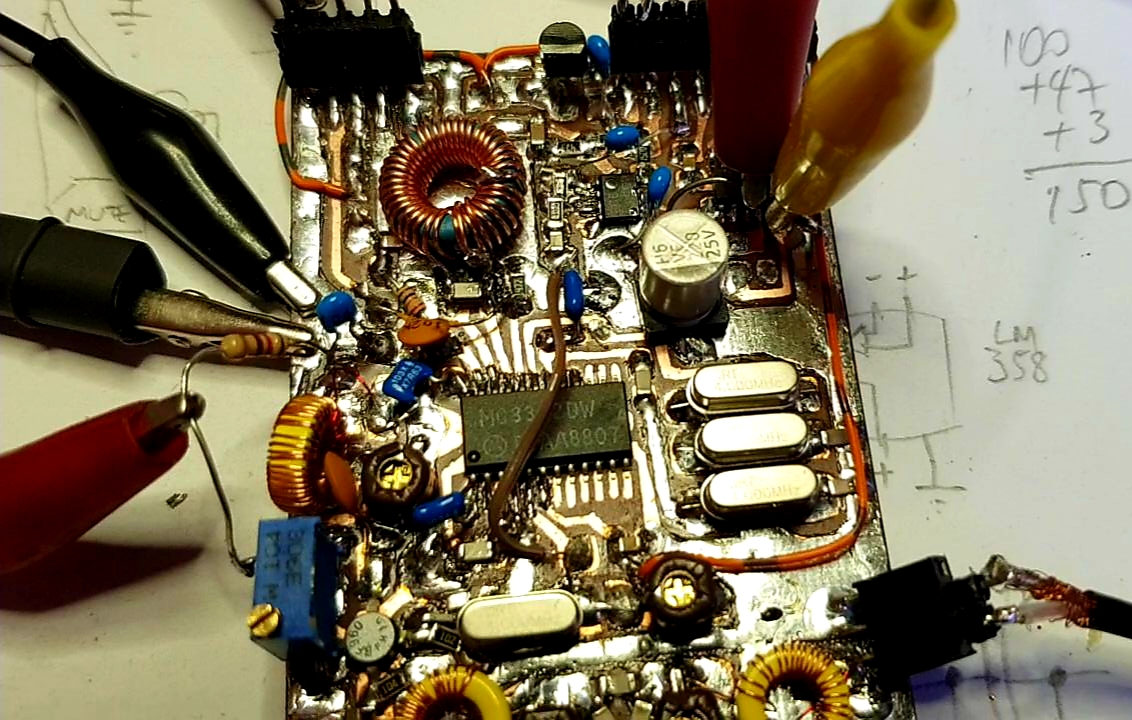
Soon the receiver was chirping out CW down the low end of 40m. I pulled the BFO 100Hz further, widened the three-crystal IF filter slightly, and called it done. Doing A-B tests with other more capable receivers, its sensitivity was perfectly acceptable. The IF filter was sharp and CW popped out when centered. A memorable moment was comfortably hearing Ellen W6YL/7 around 7010KHz one evening, just after sunset.
The Frequensee app on my Android smartphone provided a nice audio spectrum plot. Peaky around 1kHz, with a slight unexpected bump at 2kHz and a bit too much hiss at 8 to 10kHz. A 0.01uF ‘top cut’ across the volume control reduced the hiss. Final plot below.
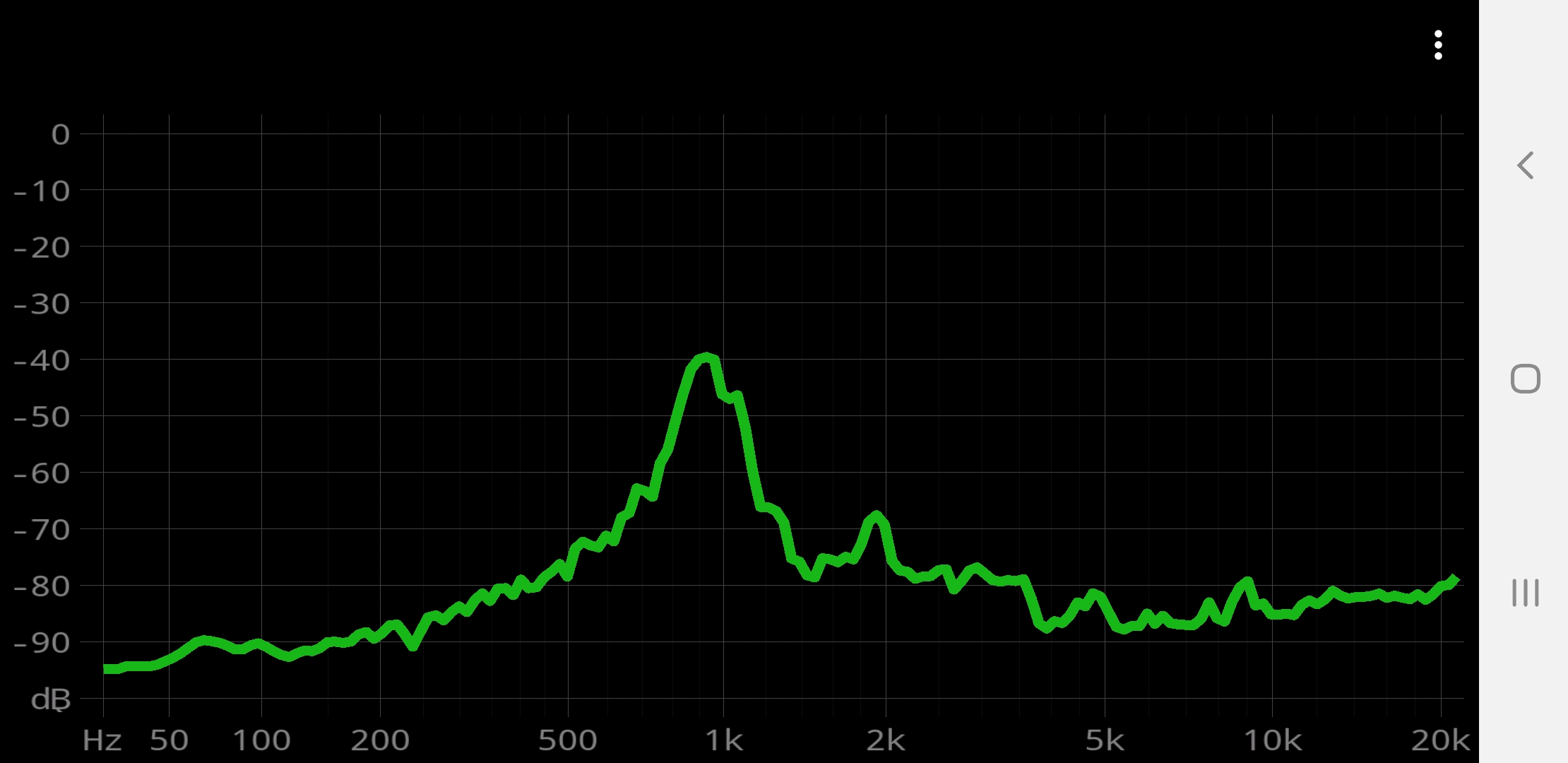
Frequency agility or not?
Next, I needed to decide whether to make the transmitter frequency agile (VFO controlled) or crystal locked. The MC3362’s VFO output could be used to drive a SA612 transmit mixer, giving a fully tuneable CW rig. This scheme adds the overhead of a transmit mixer, and post mixer Band Pass Filter, as well as the need to offset the VFO on transmit by 700Hz.
The alternative is crystals (I have a few popular CW frequencies including 7030KHz), not something I’d normally choose for a QRP rig. Crystal locked QRP transmitters violate Peter Parker VK3YEs Golden Rule of QRP Happiness — use frequency agility if you want contacts. They won’t come to you because most of them won’t hear you. So you have to go to them by calling them on their frequency. This rule makes sense for general CW work, but SOTA is different. On a summit, you can spot using your favourite SOTA app and the internet, and then, magically, a few dozen ham’s pockets buzz, or ping, or bleat, and … they come looking for you!
So being crystal locked isn’t such a problem for activators. There is one penalty — you can’t move to avoid QRM, or call another activator for S2S contacts. I opted for frequency agility — a SA612 transmit mixer and heterodyne oscillator to get the signal frequency carrier. The SA612’s internal oscillator needs just a few caps and a crystal, and can be set independently of the BFO, making it possible to get the 700Hz carrier offset.
Driver and PA
QRPp will get you contacts under good conditions but you don’t want to be left stranded on a summit with 1 or 2 QSOs in the bag and no further takers. And it’s not really fair to chasers to only use very low power. So I decided to include a 5W PA in the same box, relay switched, between the driver and Low Pass Filter. This would allow QRPp operation from a 9v PP3, or 5W QRP operation on a small LiPo pack.
I chose to use the pre-driver and driver from the OzQrp MST3 design, a 2N3904 and BD139, keying power to both. The 5W PA stage is the venerable IRF510, a fine performer on 7MHz. Simple, stable, albeit a little fragile if not heatsinked. Miniature 12v DPDT relays at either end to switch the IRF510 PA in or out.
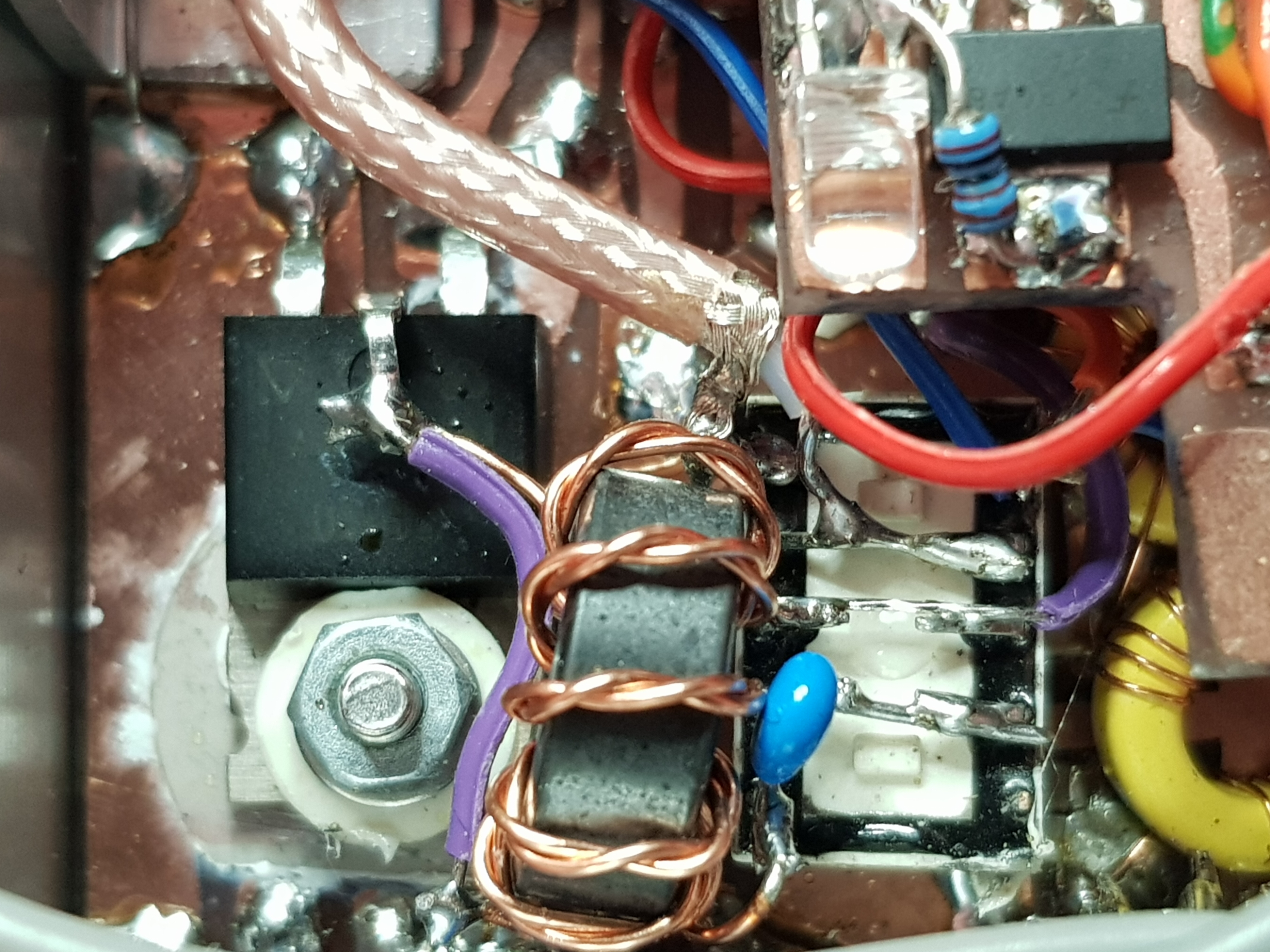
Once built, I connected up a two-transistor oscillator and buffer as an RF signal source with a 7030kHz crystal. I measured the following levels at the outputs of each successive stage in the transmitter, with a 50 ohm dummy load on the LPF output:
| Measurement point | 9V @ 37mA | 12V @ 59mA/th | 20V @ 120mA |
|---|---|---|---|
| Osc output | 280mV pp | 280mV pp | 700mV pp |
| 2N3904 output | 720mV pp | 1v pp | 2.2v pp |
| BD139 output | 4.8v pp (60mW) | 6.8v pp (125mW) | 11.7v pp (350mW) |
Pulling in the two relays, applying IRF510 bias and IRF510 drain power, the transmitter delivered 50V pp or 6 watts output into the 50 ohm dummy load, total power draw around 750mA at 12v.
The LPF was built up directly on the board using T37-6 toroids to the W3NQN design, details on the QRPLabs site.
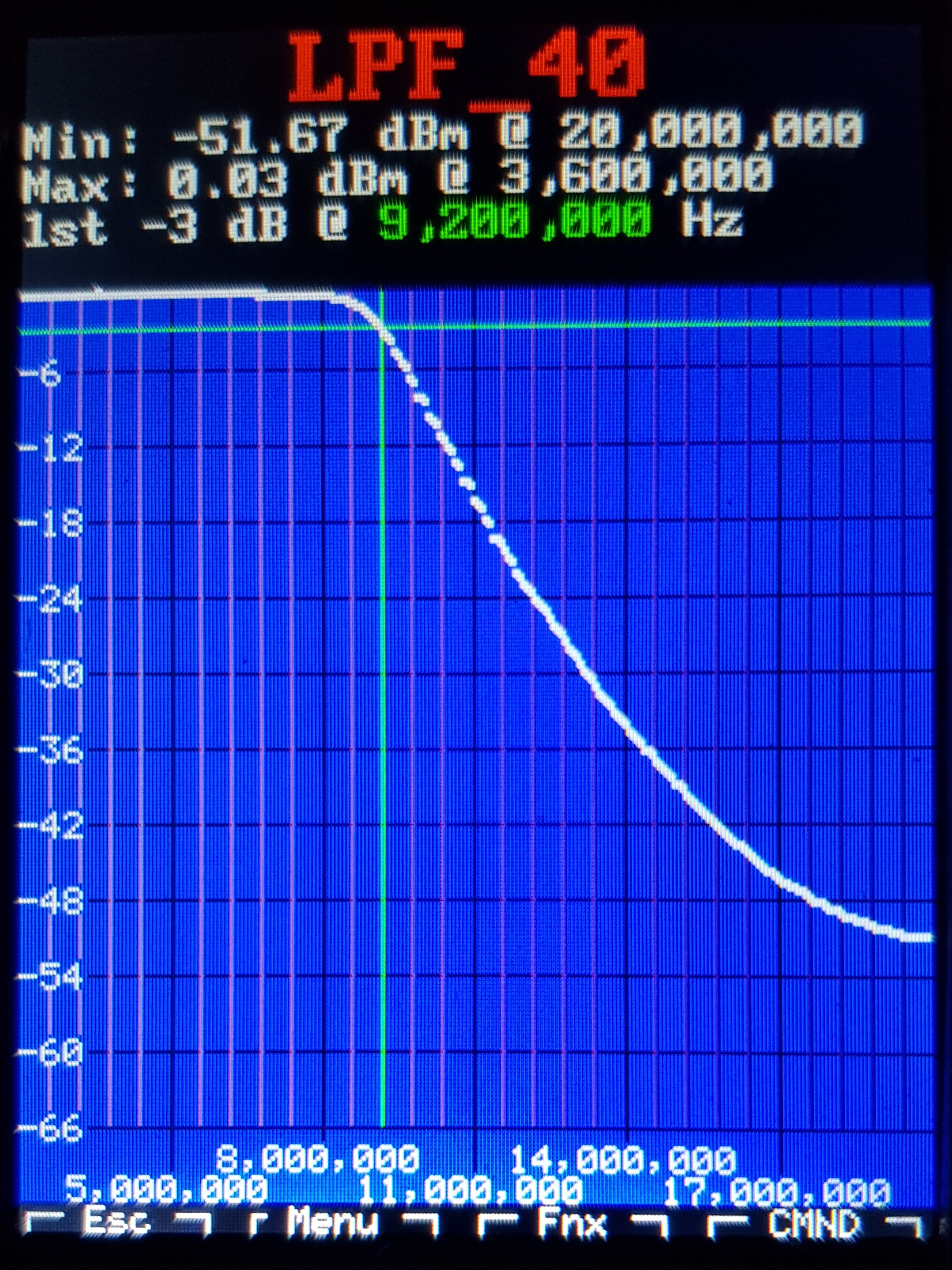
Keyer
A keyer is taken for granted in modern QRP rigs. Even the Rockmite with its tiny power and DC receiver has a PIC-based keyer. I normally have an Arduino inside the box which runs my software keyer. No Arduino this time so an alternative had to be found.
Steve K1EL has an excellent range of keyer products based on a programmed PIC in an 8 pin DIL IC. I’ve used one of these once before in a homebrew Wilderness SST for 30m. You can buy just the programmed keyer IC to build into your own projects; I ordered 2, one for spare.
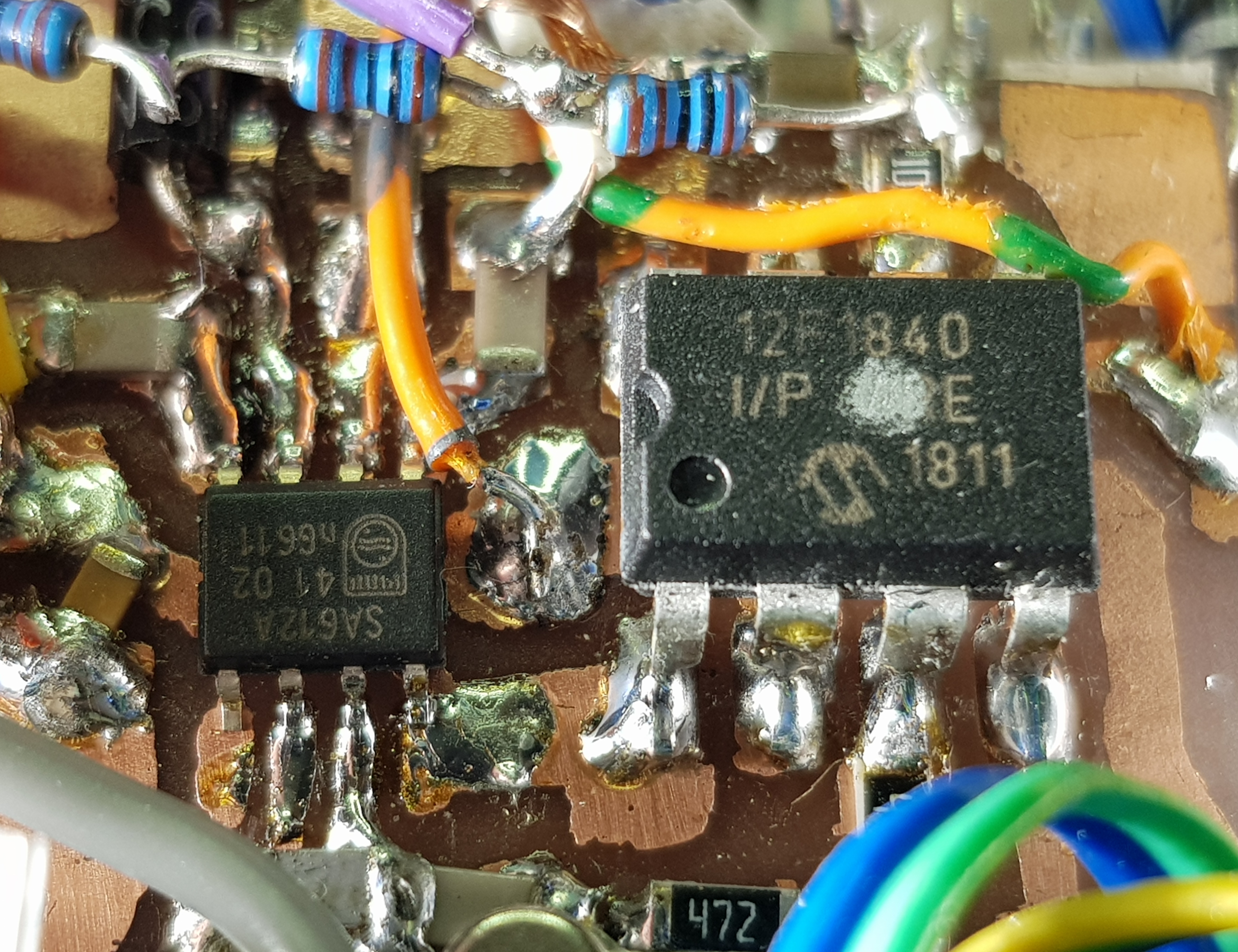 K1EL keyer on a chip (the 8 pin DIL one); the SOIC IC is the SA612 transmitter mixer.
K1EL keyer on a chip (the 8 pin DIL one); the SOIC IC is the SA612 transmitter mixer.
The KC-16 has amazing keyer capabilities, 98% of which I won’t use. It’s a full contest keyer and is widely used as such. It can be set up using just one pushbutton and the paddle by sending command sequences in CW after power-up. It has memories and can be commanded to preserve all of its state in its own EEPROM.
Another feature is a PTT pin. This goes high a (configurable) amount of time before it emits the first character, and drops after a longer configurable lag period, to control T/R switching. This little $8 chip can become the transmit/receive controller as well.
Casing, switchery, socketry
I made the receiver board to snugly fit inside a length of 2mm aluminium angle, to provide shielding and physical stability. The transmitter board was then constrained to sandwich just above it. An aluminum base plate was made with end angle pieces for the front and rear panels. This metal-work had to be done before the transmitter boards were cut from PCB stock to ensure everything, including panel controls, would fit. That’s the advantage of scratch- building your own case and boards, you can make them all fit perfectly.
A little bit of thought goes a long way at this stage. For example, I was able to use the right rear M2.5 bolt to retain and heatsink the IRF510. Use one bolt (fixing) for several purposes, if you can.
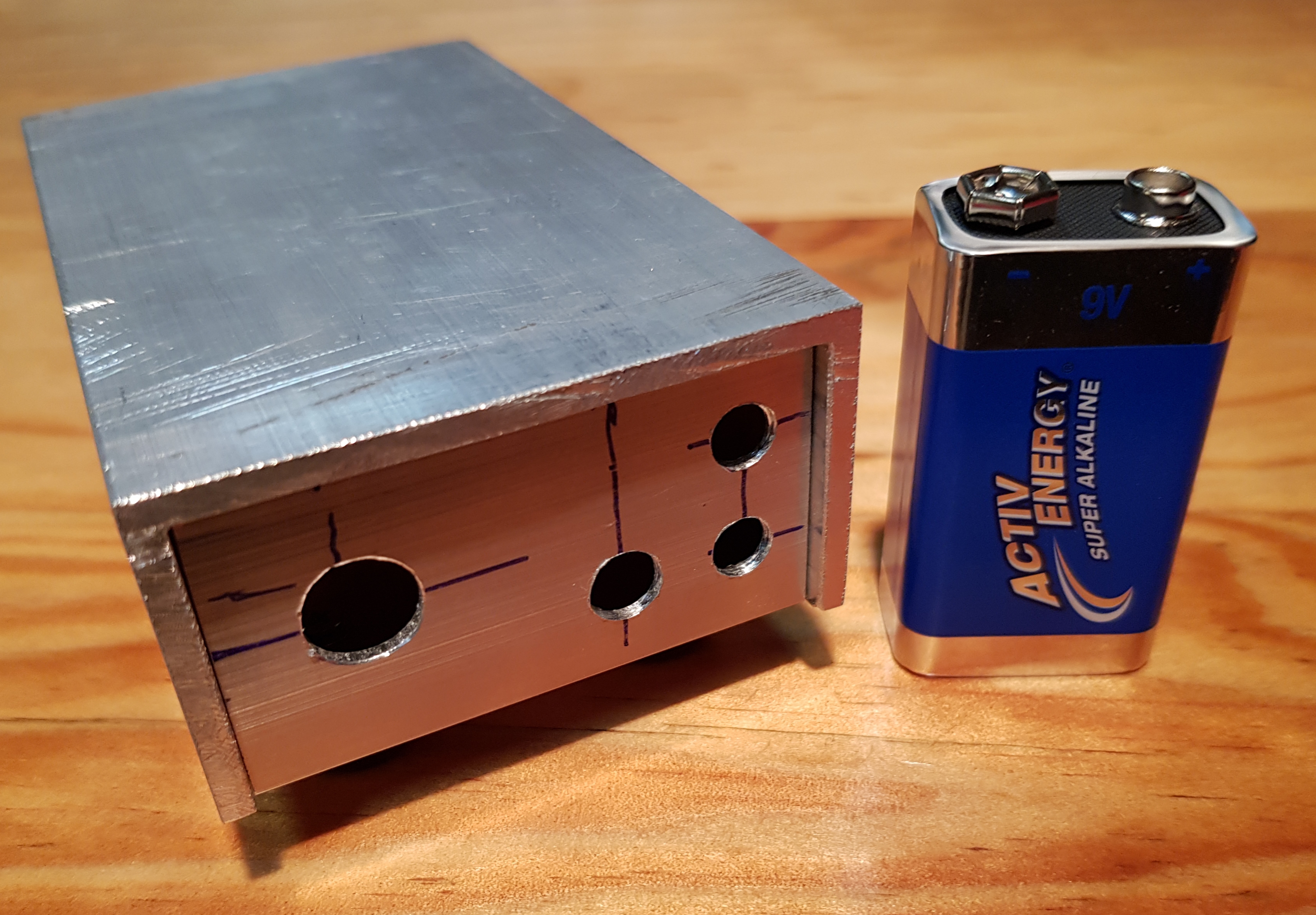
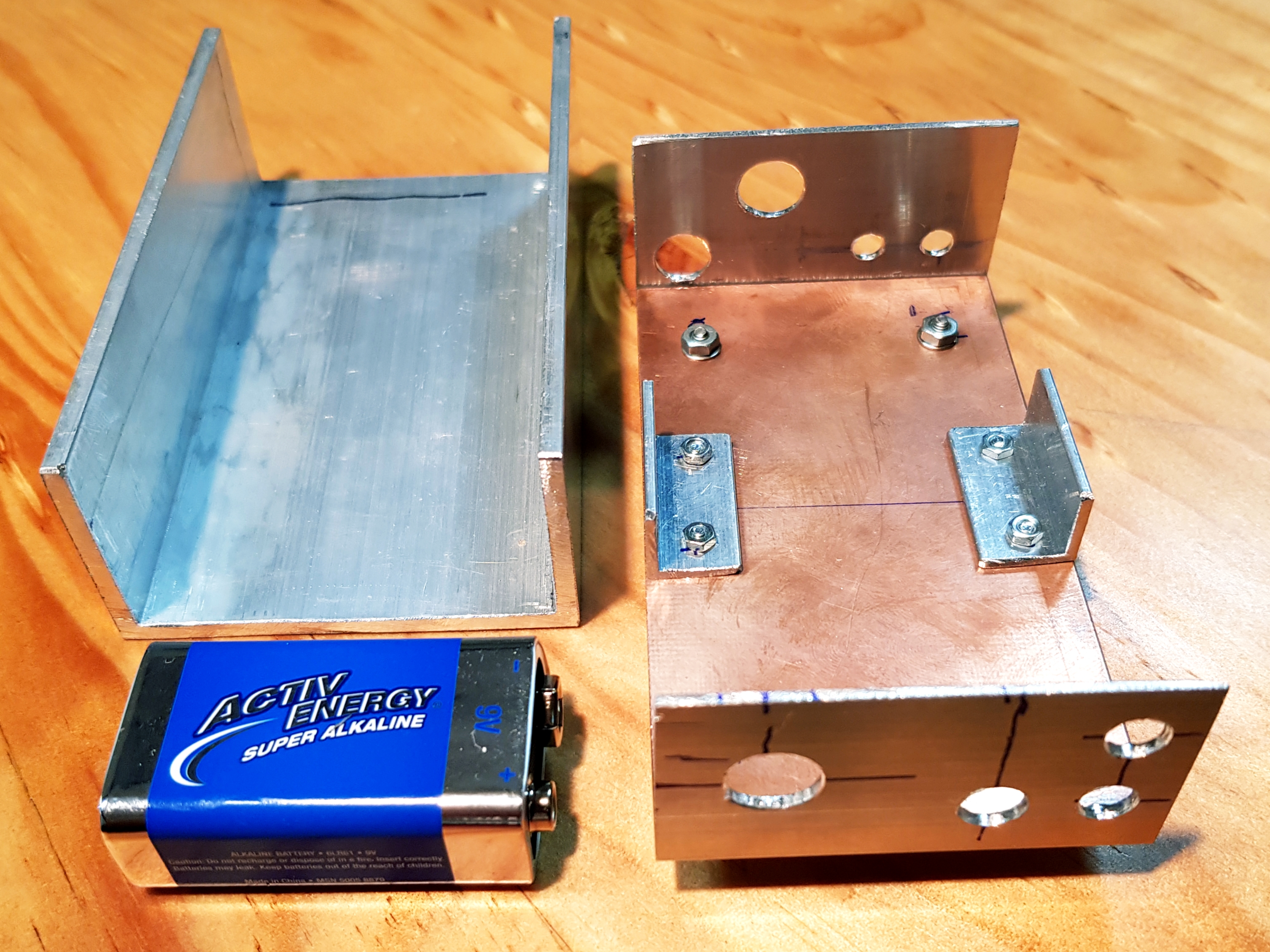
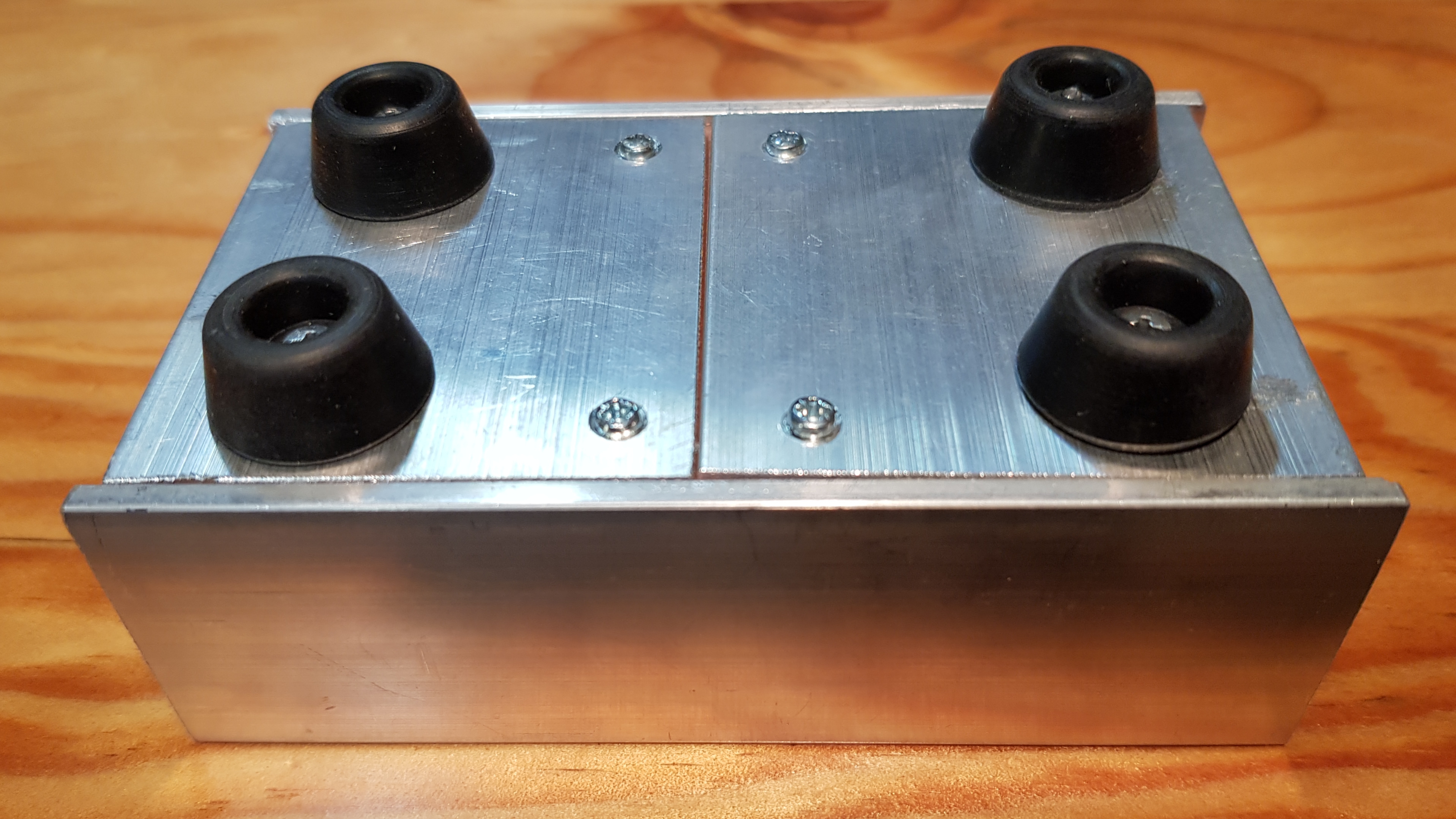
Fitting it all in was tight.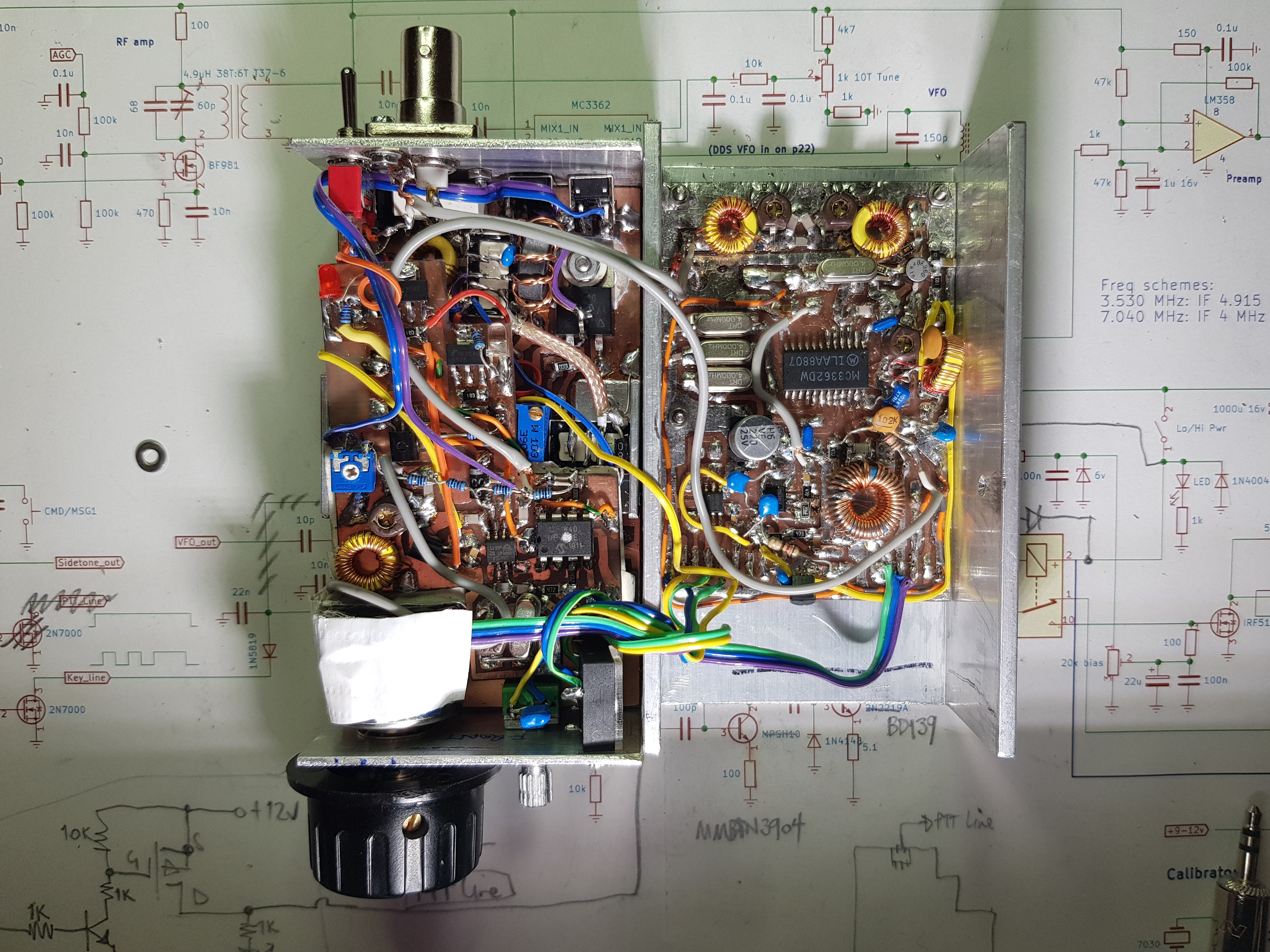
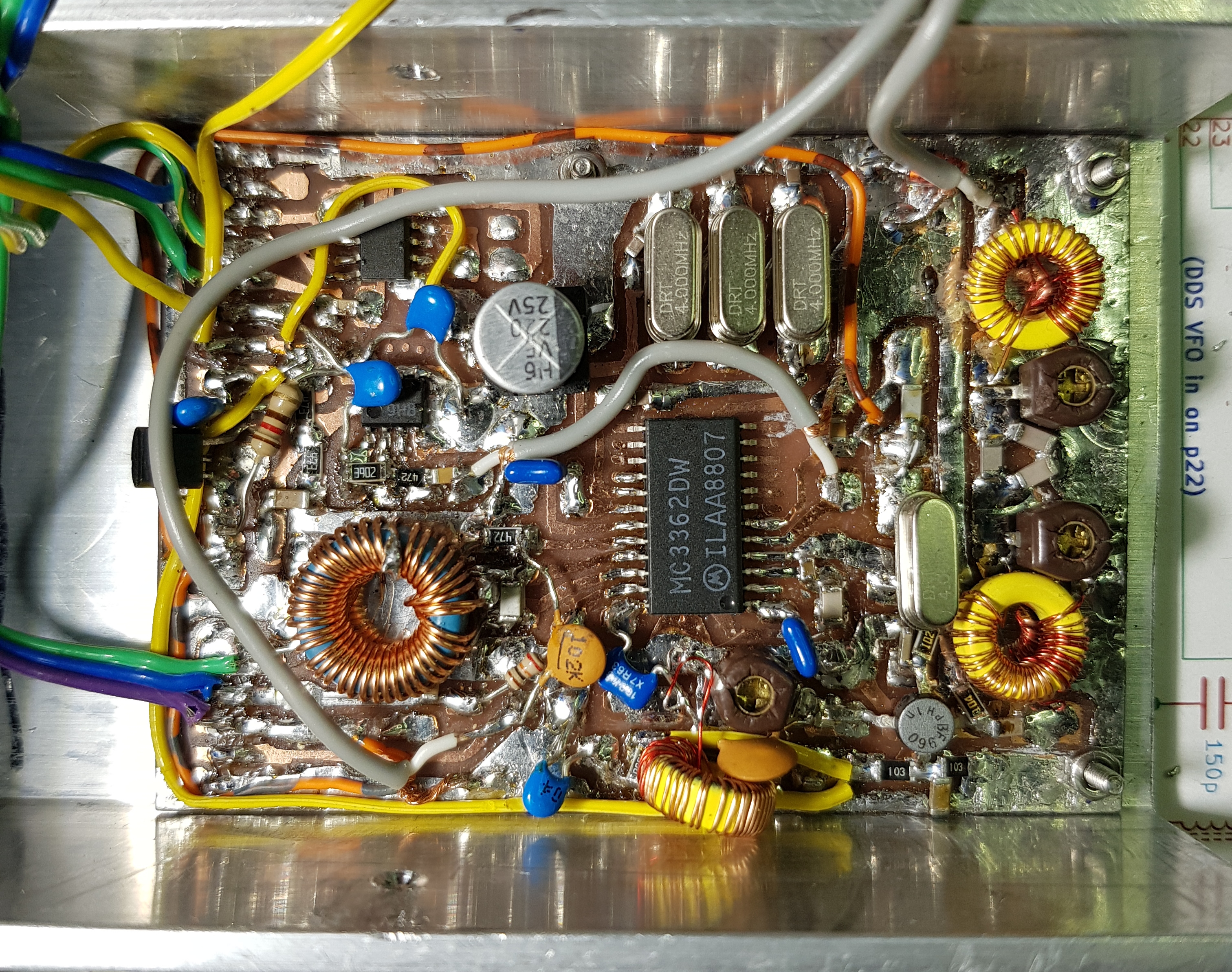
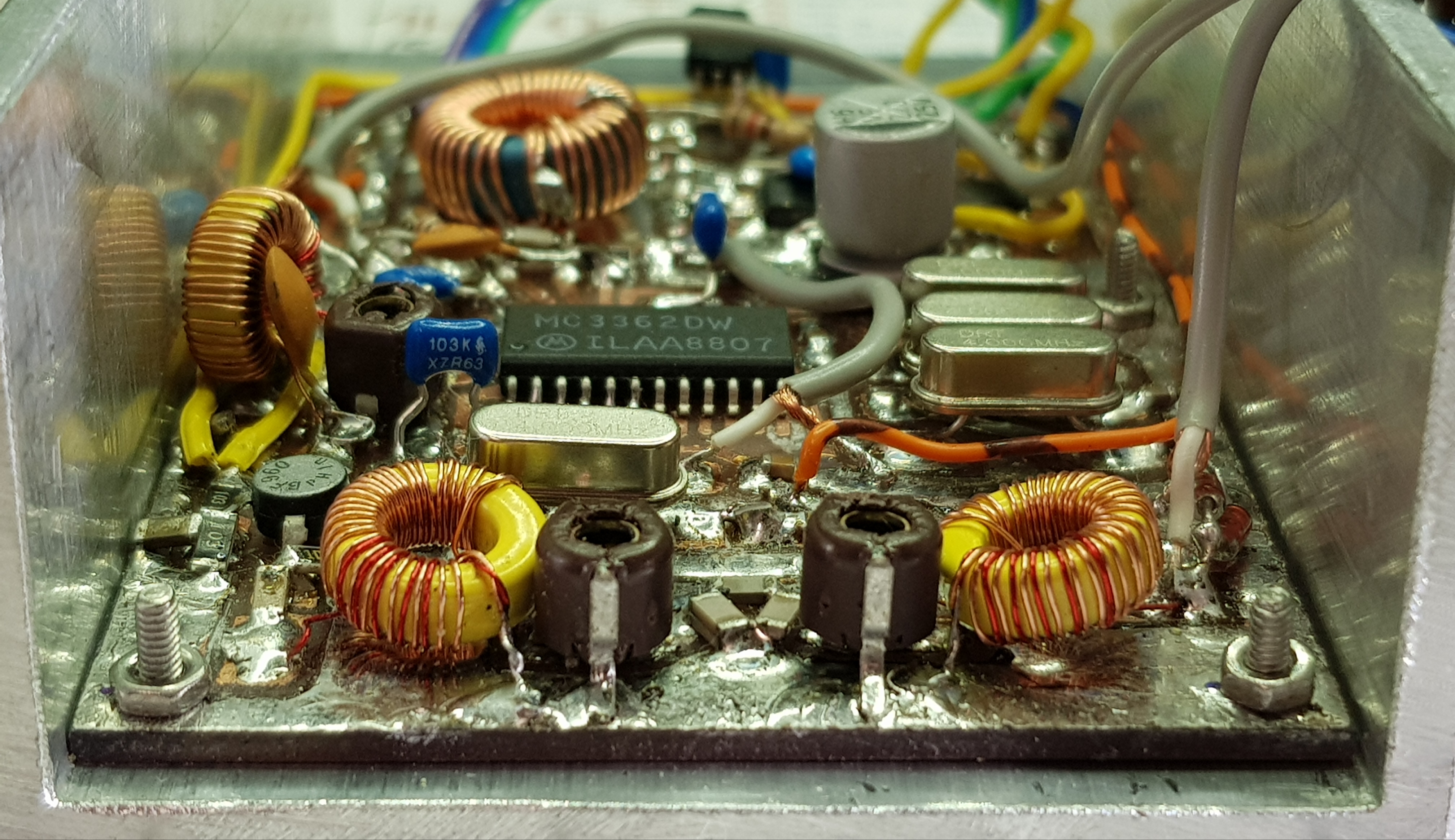
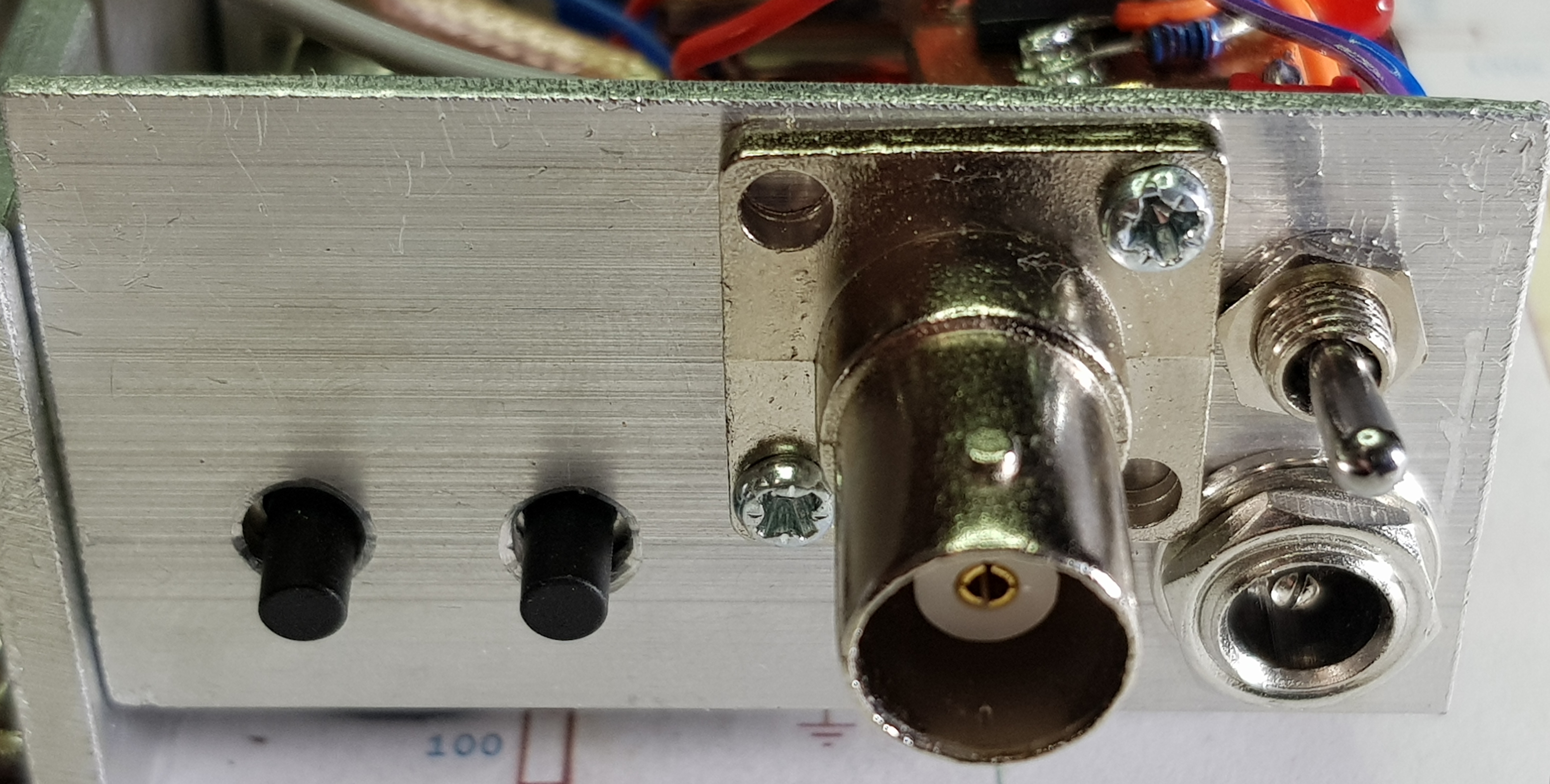
Tuning
One thing has not been mentioned yet — tuning and frequency display. The MC3362’s VFO oscillator is internally varactor-tuned using an external 1k ten turn potentiometer. This gives a good tuning speed over the 60kHz of coverage, but presents a familiar problem of how to indicate the frequency.
In earlier projects I’ve used a cheap eBay frequency counter (reading the VFO with a configurable IF offset applied). I’ve also used the old school method of a 6:1 vernier reduction drive (Jackson Brothers of London) driving a one turn potentiometer with an opaque perspex disc with frequency markings. Both of these options seemed too complicated and physically large for this project. So I decided on the simplest alternative — no frequency display.
So when you want to call CQ how do you put your tuning dial on a known frequency? Easy. You press a push-button which powers up an in-built crystal oscillator (on 7030kHz) and zero-beat the receiver to it. Then spot 7030.7. If 7030 is busy, you’re on your own!
On a SOTA summit
My first attempt to activate with this rig was on Mt Little Joe VK3/VC-027 on 25th October 2019 with VK3KR. After a number of calls on QRPp late in the afternoon (with several spots announcing my QRPp signal), no takers. I then went to another rig (5 watts of CW) and worked some VKs and finally, a station in France!
It took me until early autumn, the 27th of February 2020, to get back onto a SOTA peak with this rig. Making the most of remaining late summer long days I left work and made a rendezvous with David VK3KR at Mooroolbark Station for the 20 minute drive up to the Sky High Restaurant car park at Mount Dandenong, VK3/VC-025, Melbourne’s closest SOTA summit.
This place has been a favourite sunset-watching spot for Melburnians for generations, as the car park and restaurant offer uninterrupted views west over the entire city. If weather conditions are favourable it can be quite a view as the city lights come on at dusk.
This place has also seen a lot of VK3 VHF and UHFers over the decades as well. David brought 2m SSB and our hopes were high for some excellent SSB contacts using his homemade 4 element collapsible beam. The video of that activation is here. Although I made three 40m CW contacts, HF conditions were terrible, each station was barely Q5, reports were poor, and I had to revert to a second transceiver to complete the activation.
I knew this little rig could do better, so a few weeks later on Sunday March 15th I returned to Mt Dandenong for a solo activation, captured on the video at the head of this post. This time conditions were good, with a string of VK2, 3, 4 and 5 chasers against a background of strong American and European DX context callers. Having done a complete SOTA activation the rig could now be officially declared a ‘Summit Prowler’ (6b).
Wrap-up
Overall, this project achieved its aims, delivering a compact CW monobander capable of running at several QRPp levels — 60mW at 9V, 125mW at 12V, 350mW at 20V. It’s tunable from 7010 to 7070kHz, and has a fully integrated, switchable five watt afterburner. The receiver is a single conversion superhet with narrow CW filter and the kind of sensitivity you expect from a portable rig.
As to the VK QRPp Challenge, various QRPp CW contacts were made, but I was not among them. Unfortunately I didn’t make any QRPp contacts with this rig — but I am sure milliwatt persistence would have paid off. A better design would be to have a continuously variable power control, so that you could call on 250mW, then 1W, then 5W as conditions allowed.
As the video demonstrates, on the 5 watt setting the rig is entirely feasible as a CW activator’s monobander. I’ll keep it in my kit for times when I want a fast CW-only activation with minimal radio gear.
Design notes
A few comments on this design, and, what I might consider doing differently next time.
TDA7052A balanced output
The TDA7052A audio IC is a fine little 1 watt audio amp with a DC gain pin that affords AGC. My surface mount (SOIC) version is loud enough to drive a speaker in a quiet room. But the output is balanced, not single-ended against earth. This means you cannot use a conventionally wired 3.5mm jack on an earthed front panel. My workaround was to bring the balanced audio to the 3.5mm socket’s tip and ring, then make up a patch chord with a stereo 3.5mm plug wired to match at one end, and a conventionally wired 3.5mm line socket at the other.
This is a compromise — for one thing, there’s a normal looking 3.5mm socket on the panel but if you plug in a speaker it won’t work! Also, if I lose the custom adapter the rig is useless. This would not be such a problem if the rig had an internal speaker, but I couldn’t fit one in such a compact package.
The other commonly used option is to insulate the 3.5mm speaker socket from the aluminium panel. I haven’t found a source of floating 3.5mm sockets that will do that. And making up a perspex back-plate just wouldn’t work in a small rig. It’s almost enough to ditch this otherwise fine audio amp IC for an LM386.
Keying and transmit DC supply
A CW transmitter design like this needs to solve two problems — how to key the transmitter, and where to apply +12 volts to the transmitter gain stages on key down. The K1EL keyer IC addressed both these needs, by supplying a PTT line that I used to drive a FET DC switch that puts 12V on the pre-driver and driver, and pulls in the T/R relay. It has settable pre and post character delays, perfect for controlling a rig in a semi-break-in mode.
The actual carrier is keyed by the K16 keyer’s CW output, which drives a 2N7000 switch that grounds the earth pin of the SA612 mixer and transmitter carrier oscillator. In high power mode there is some CW chirp which may derive from insufficient power rail routing and possibly decoupling. I’ve not investigated this further.
VFO drift
The free-running VFO drifts about 100Hz every minute after switch-on, regardless of hi or low power. On the second Mt Dandenong activation which lasted over an hour, the drift was minimal by the end of the session, so it must be related to temperature changes inside the box.
VFO drift is novel — several of the chasers commented on it — but not really acceptable in this day and age, even for a simple homebrew CW rig. To improve it, a separate shielded VFO or moving to a crystal super-VXO would be necessary. Both options would use more space and each has pros and cons.
Monitoring (side tone)
I got away with just leaving the receiver on during transmit. The received transmitter signal is a bit loud but responds to the volume control. A more sophisticated design would mute at least the receiver front end and provide sidetone level setting.
Size
Cramming this type of hand-made construction into a small space is a challenge. With a bit more design effort and selection of all surface mount parts it could be done on a properly designed multi layered offshore- fabricated PCB. That exercise is a project in itself and is left to others.
Other compact CW monobanders
There are lots. The QRPLabs QCX is the standout in terms of availability as a very affordable kit, and receiver performance. The Steve Webber KD1JV designs are excellent if you are considering a scratch build, and if you can find the construction details (e.g. SodaPop). Built KD1JV rigs such as the Mountain Toppers are only available on the second hand equipment market and are pricey here in VK. I built a Wilderness SST a few years back with very good results. I also looked at Miss Mosquita from the German QRP group, and recently built by Warren VK3BYD. The venerable EMRFD is full of inspiration for simple CW transceiver modules, from which you could chose to suit your purposes.
Acknowledgement
Thanks to Ron VK3AFW for proposing and organising the QRPp SOTA challenge. Thanks to the VK and ZL SOTA CW chasers who dig deep to pull out tiny signals on noisy bands.

I erroneously omitted the comments option on this post, so 3 years of comments have been lost! 8^( My bad!
LikeLike
This comment was posted to About page, copied here by VK3HN to keep this thread on the right page.
Hello Paul.
Commenting here as I cant see any option to coomentb on the specific entry. Anyway I wantted to thank you for your post describibg the Summit Prowler 6B. As someon73e who loves hiking and /P amateur radio opperation I’ve been playing with such lightweight rigs for some time. My latest project design was essentially going around in circles trying to figure out a low current but effective portable TXVR. Then I came across your summit prowler 6B. Immediately interest was tweaked!
I quickly became aware that the MC3362 had been superceded by another chip the MC13125 which has possibly slightly better specs (although I cant confirm this as I dont have adaquate hi spec test gear right now. However, haveing obtained a few of these chips I have a prototype laying on the work bench and its working rather well. A lot more to be done to get it up to a state where I can stick it in my backpack and head off into the mountains but its looking promising! thanks for the inspiration!!
73 de Kat MM0BST/M0BST
LikeLike
Hi Kat,
Many thanks for your kind comments and your interest in this great little QRP CW project. I have not followed developments in these radio on a chip devices so thanks for alerting me to MC13135. They are of course obsolete now but I see there are a few available on eBay and a surplus site. I think these FM receivers on a chip are an excellent choice for a simple superhet for CW or SSB, they do most of the work, and you can address the limitations yourself if you wish by using an external VFO, and as little or as much external gain and filtering as you like.
Do keep me informed as your pocket QRP CW rig progresses. I hope you might find some of the other circuit parts if not useful then illustrative. There is more to getting a CW tranasceiver with semi breakin going than people realise, it’s all in the TR switching and receiver muting.
If you want to learn more about CW transceiver design, I recomment two videos by Dave Bensen K1SWL speaking at FDIM last year about ‘designing a better mousetrap’. I also have a series of videos as a playlist called 2B2C (2-band 2-channel) in which I go thru design, construction and testing of a really simple but usable crystal locked 2 band 5 watt CW rig.
73 and let us know how you progress. Paul VK3HN.
LikeLike